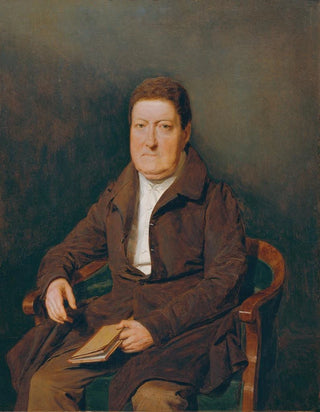Art print | M. Wohlleben, brother of the mayor of Vienna Stephan Edler von Wohlleben - Ferdinand Georg Waldmüller


View from behind

Frame (optional)
In the rich panorama of 19th-century Austrian art, the work of Ferdinand Georg Waldmüller stands out for its ability to capture the very essence of its subjects. The art print M. Wohlleben, brother of Vienna's mayor Stephan Edler von Wohlleben - Ferdinand Georg Waldmüller, is a shining example of this mastery. Waldmüller, known for his realistic and intimate approach, manages to establish a dialogue between the viewer and the subject, revealing deep emotions through meticulously detailed work. This painting, depicting a man in full contemplation, evokes not only the individual portrayed but also the social and cultural context of the time, offering a window into a Vienna full of vitality.
Style and uniqueness of the work
Waldmüller's style is characterized by striking realism, where each element of the painting contributes to the overall harmony of the composition. In this piece, light plays a predominant role, illuminating M. Wohlleben's face and highlighting the textures of clothing and accessories. The colors, carefully chosen, create a warm and welcoming atmosphere, while emphasizing the importance of the subject. M. Wohlleben's posture, both relaxed and thoughtful, conveys a certain nobility, while also revealing an accessible personality. Waldmüller thus manages to transcend the simple portrait to offer a lively and authentic representation, where the individual becomes a reflection of a society in transition.
The artist and his influence
Ferdinand Georg Waldmüller, born in 1793, is often regarded as one of the pioneers of realism in painting. His artistic journey is marked by a desire to move away from the academic conventions of his time. Influenced by Romantic movements and ideas of nature, he develops a style that favors direct observation and faithful representation of subjects. Waldmüller does not merely paint portraits; he immortalizes moments of life, emotions, and human relationships. His influence is palpable in Austrian art, where he inspires many artists to explore similar themes. Through his works, he invites

Matte finish

View from behind

Frame (optional)
In the rich panorama of 19th-century Austrian art, the work of Ferdinand Georg Waldmüller stands out for its ability to capture the very essence of its subjects. The art print M. Wohlleben, brother of Vienna's mayor Stephan Edler von Wohlleben - Ferdinand Georg Waldmüller, is a shining example of this mastery. Waldmüller, known for his realistic and intimate approach, manages to establish a dialogue between the viewer and the subject, revealing deep emotions through meticulously detailed work. This painting, depicting a man in full contemplation, evokes not only the individual portrayed but also the social and cultural context of the time, offering a window into a Vienna full of vitality.
Style and uniqueness of the work
Waldmüller's style is characterized by striking realism, where each element of the painting contributes to the overall harmony of the composition. In this piece, light plays a predominant role, illuminating M. Wohlleben's face and highlighting the textures of clothing and accessories. The colors, carefully chosen, create a warm and welcoming atmosphere, while emphasizing the importance of the subject. M. Wohlleben's posture, both relaxed and thoughtful, conveys a certain nobility, while also revealing an accessible personality. Waldmüller thus manages to transcend the simple portrait to offer a lively and authentic representation, where the individual becomes a reflection of a society in transition.
The artist and his influence
Ferdinand Georg Waldmüller, born in 1793, is often regarded as one of the pioneers of realism in painting. His artistic journey is marked by a desire to move away from the academic conventions of his time. Influenced by Romantic movements and ideas of nature, he develops a style that favors direct observation and faithful representation of subjects. Waldmüller does not merely paint portraits; he immortalizes moments of life, emotions, and human relationships. His influence is palpable in Austrian art, where he inspires many artists to explore similar themes. Through his works, he invites






